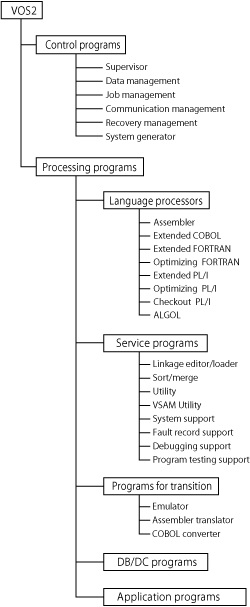VOS2 was the first OS for the HITAC M series, which was a series of Hitachi's general-purpose computers . VOS2 was equipped with functions such as virtual storage of up to 16 MB, a new virtual storage access method , a real-time processing function based on control programs, and enhanced language processors.
Figure 1 shows the system configuration of VOS2.

- Home >
- Historical Computers in Japan >
- Mainframe OS >
- VOS2
【Hitachi】 VOS2

Hitachi announced VOS2 in November 1974, and started shipping it in September 1975.
VOS2 had the following features as an OS for medium to large machines:
| Feature | Description |
|---|---|
| Adoption of a virtual storage function | A virtual storage function relaxes the limit on storage size, facilitating creation and maintenance of programs and enabling flexible center operation. |
| Enhanced DB/DC function |
Has an enhanced DB/DC function as a system through integration with the programs for DB/DC. Provides the following functions for real-time processing in particular:
|
| Full lineup of functions for online real-time processing | Supports online control programs TCS and TMS to increase the processing capacity of the control program and strengthen anti-fault measures. |
| Enhanced multi-job processing function |
|
| Function for making programs resident and sharing them | Function to make programs, such as access method routines, transient SVC routines, transient error recovery routines and reentrant user programs, resident on virtual storage or real storage, enabling all jobs in the system to share the programs. |
| Virtual storage access method VSAM | A new access method that features independence from the device. Two types of access are available: entry sequenced access in which access is made in the order of entry of records, and key sequenced access where access is made with keys contained in the records. |
| Enhanced language processors |
Has an enhanced range of language processors in response to various requests from the market. Provides multiple processors, even for one programming language, according to use:
|
| Enhanced RAS function | Provides functions for retry of instructions, separation of the fault page, alternate path retry in channel fault and dynamic reconfiguration of devices against I/O fault. All faults are logged out to a specified data set and used as material for maintenance. |
| A rich range of programs for transition from the 8000 series | Provides emulators for DOS/EDOS/EDOS-MSO, assembler translator and COBOL converter, in order to facilitate transition from the 8000 series. |
All Rights Reserved, Copyright (C) Information Processing Society of Japan
